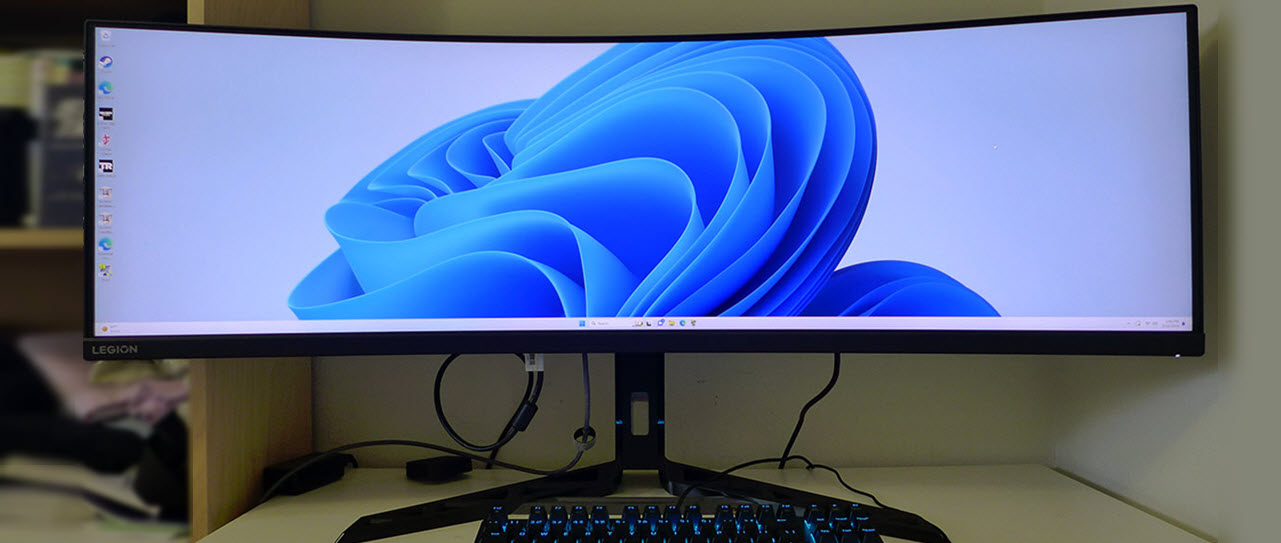Why you can trust Tom's Hardware
The R45w-30’s default picture mode is Standard, and it isn’t too far off the mark. It benefits from calibration, but some users might be satisfied with its native state.
Grayscale and Gamma Tracking
Our grayscale and gamma tests use Calman calibration software from Portrait Displays. We describe our grayscale and gamma tests in detail here.
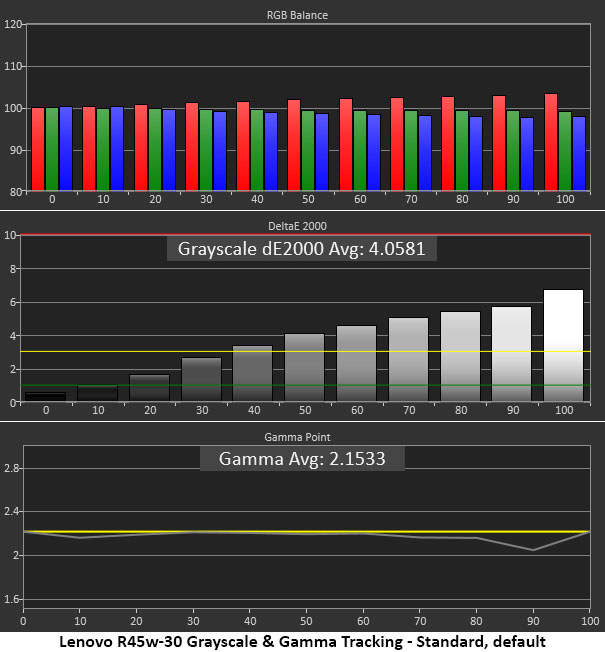
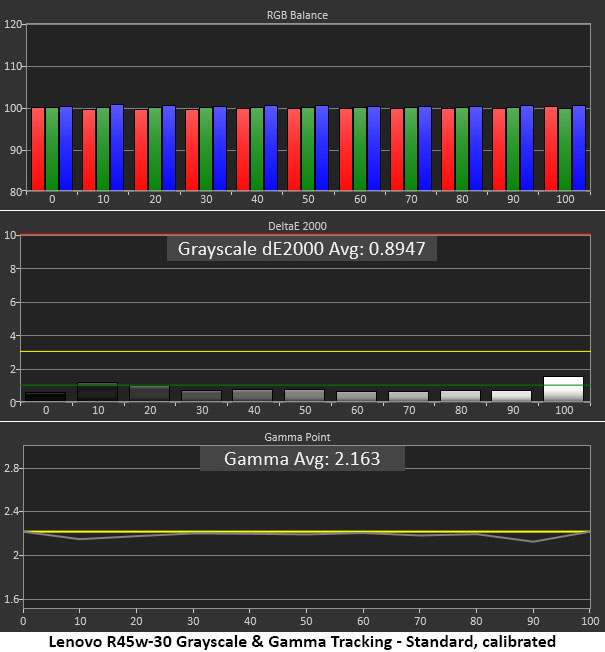
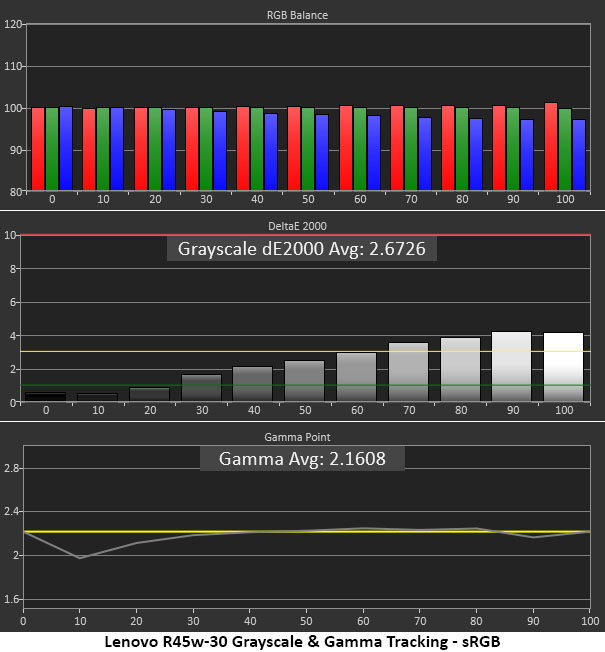
You can see the R45w-30’s warm tone in the first chart above. The error is only a tad over the visible threshold, so not all users will notice it. If a monitor is to have a grayscale error, red is preferable to green or blue because it is less obvious. Gamma tracking is perfect except for the 90% step, which is a tad too light. This has no significant effect on picture quality either.
Calibration removes all grayscale errors and achieves pro-level accuracy. Gamma is improved with only tiny dips (too light) measured at 10 and 90%. This is excellent performance. Remember that the R45w-30 is a value-oriented monitor.
If you engage the sRGB mode in the color temp menu, grayscale is fixed with slight red/green errors at brightness step 70% and higher. This is acceptable for most graphics editing scenarios but is a little shy of the qualifications needed for the most exacting color grading work. This is acceptable performance and I’m glad to see that the R45w-30 includes a usable sRGB mode.
Comparisons
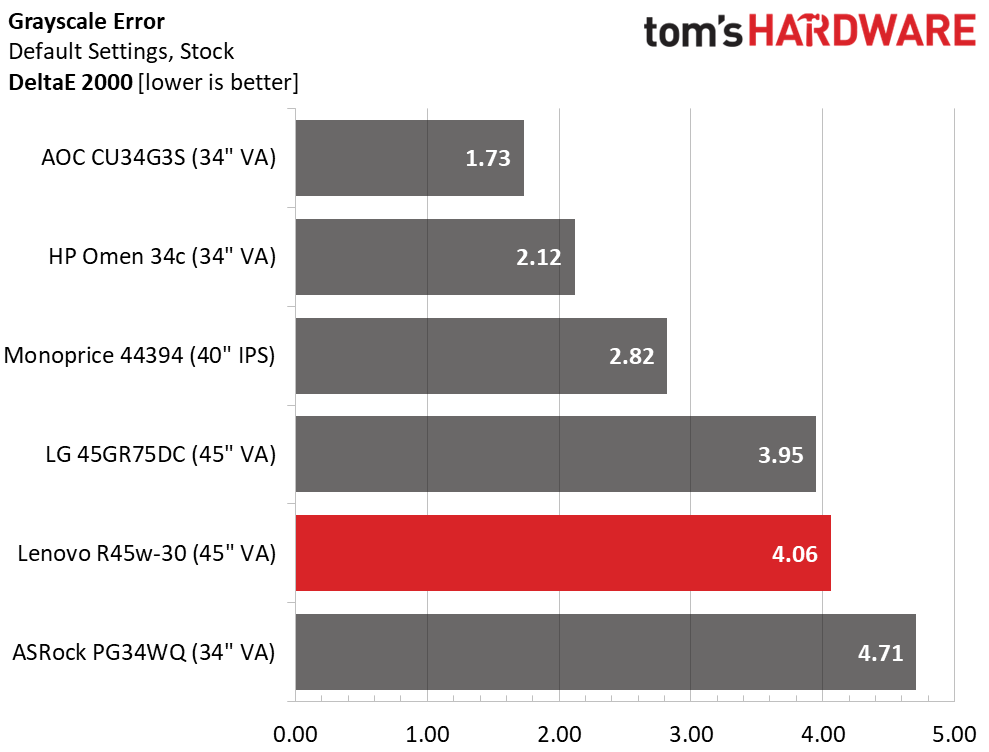
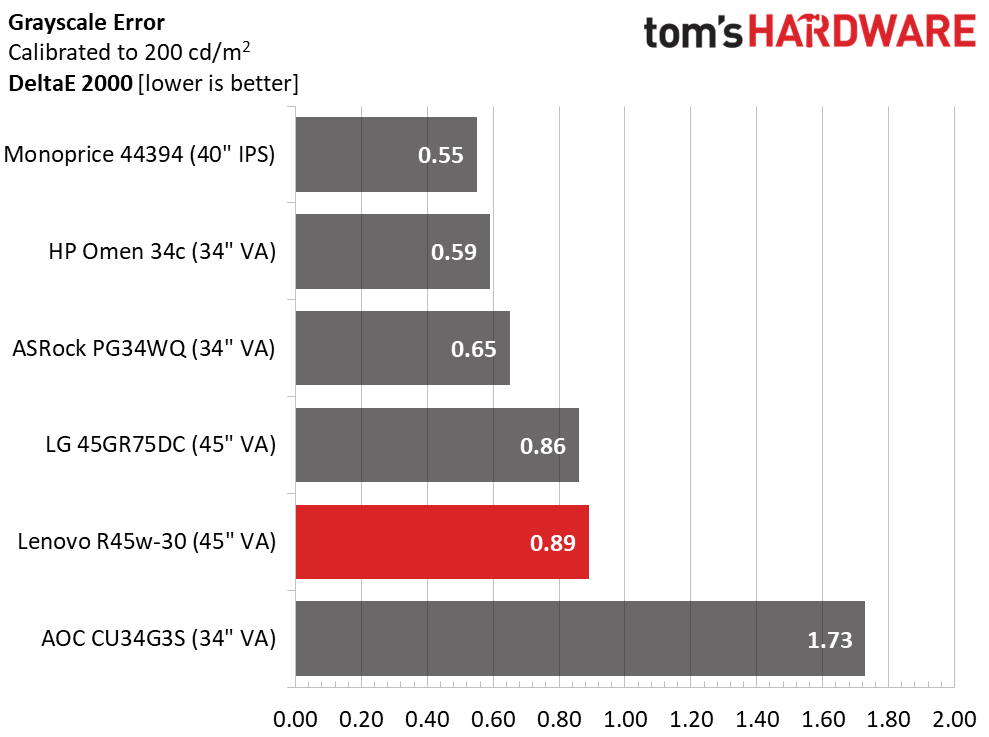
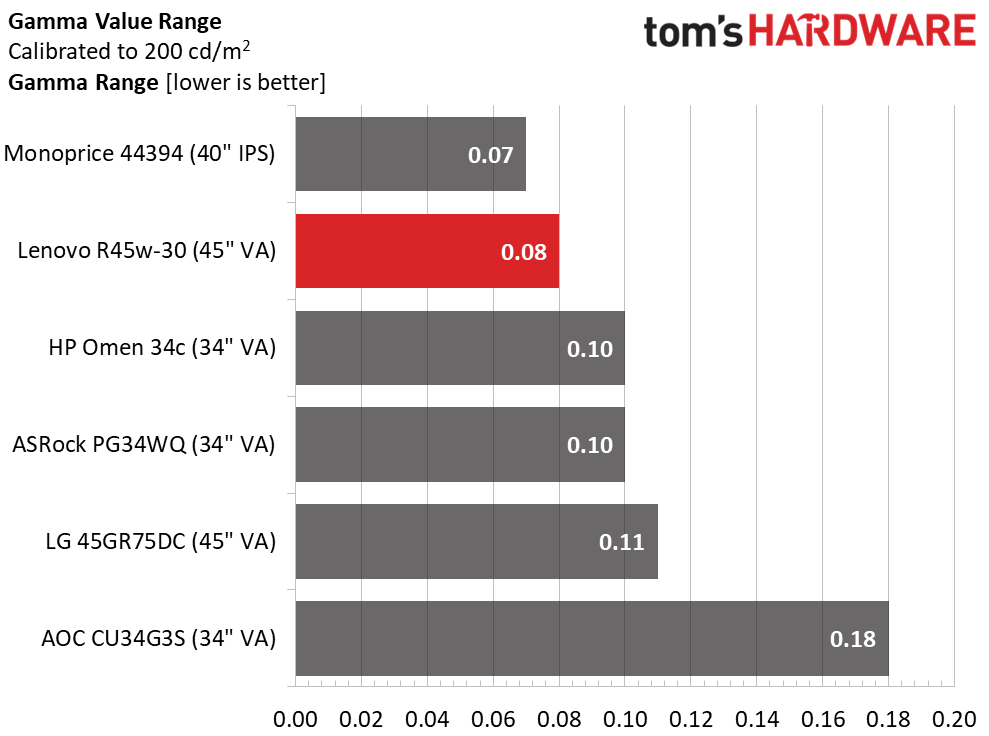
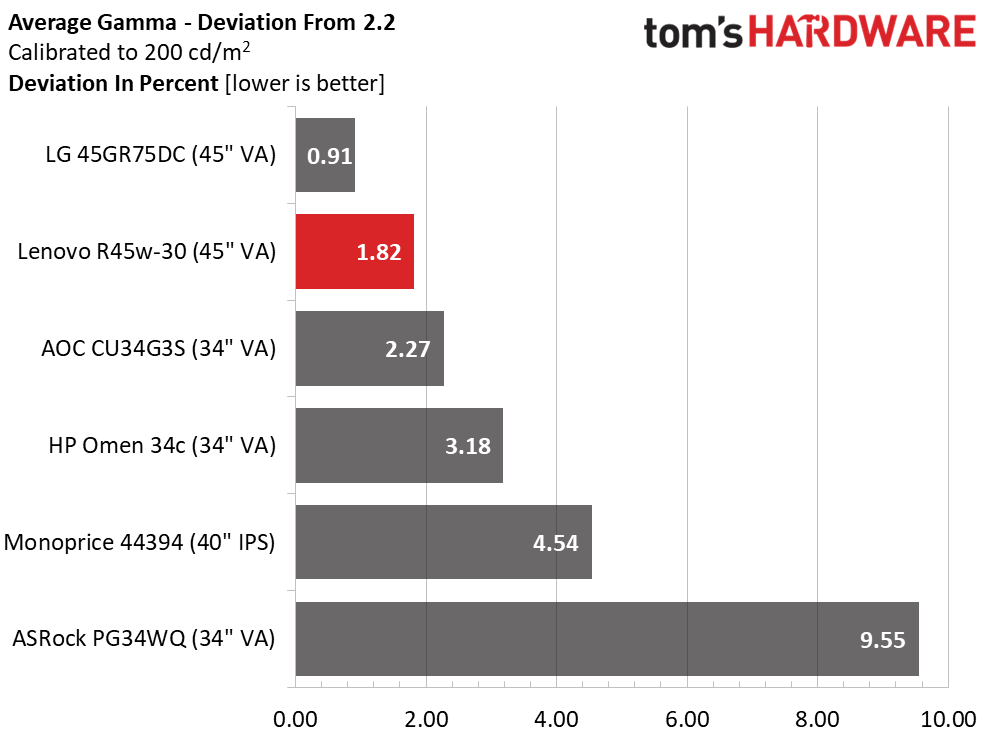
4.06dE isn’t a great default grayscale score for the R45w-30, but it is at least a red error rather than green or blue, which are more deleterious of image quality. Things look much better after calibration, which despite the fifth-place finish, is still a pro-level result. All the panels are impressive in this test.
The R45w-30 does very well in the gamma comparison with a tight 0.08 range of values and a 1.82% deviation from the 2.2 reference. The actual value is 2.16 and that is due solely to the slight dips at 10 and 90% brightness. All other steps are on the 2.2 line. This is excellent performance.
Get Tom's Hardware's best news and in-depth reviews, straight to your inbox.
Color Gamut Accuracy
Our color gamut and volume testing use Portrait Displays’ Calman software. For details on our color gamut testing and volume calculations, click here.
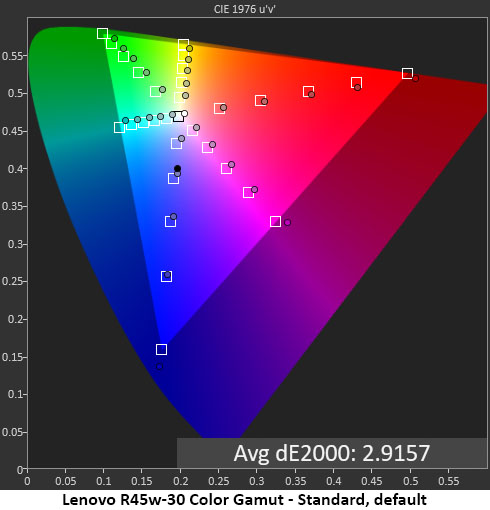

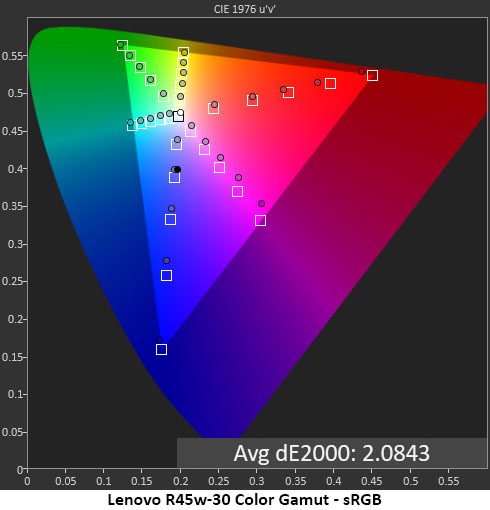
The R45w-30’s native gamut covers a good portion of DCI-P3 and hits the target points with only slight deviation. You can see hue errors in cyan, magenta and yellow, which are a byproduct of the reddish white point.
Calibration reduces the error value slightly and tightens up the hues for yellow and cyan. Magenta is still slightly off and red is now a tad under-saturated. The visual difference is extremely small. The picture looks better, thanks to the improvement in grayscale and gamma tracking. Color is essentially the same. Like most wide-gamut screens, green is a little under-saturated. This is very good performance.
The sRGB result is similar with off-hue magenta and a little under-saturation in red. The sRGB mode is suitable for most graphic editing but there is a little room for improvement. It is, however, better than most value screens which don’t have usable sRGB modes.
Comparisons
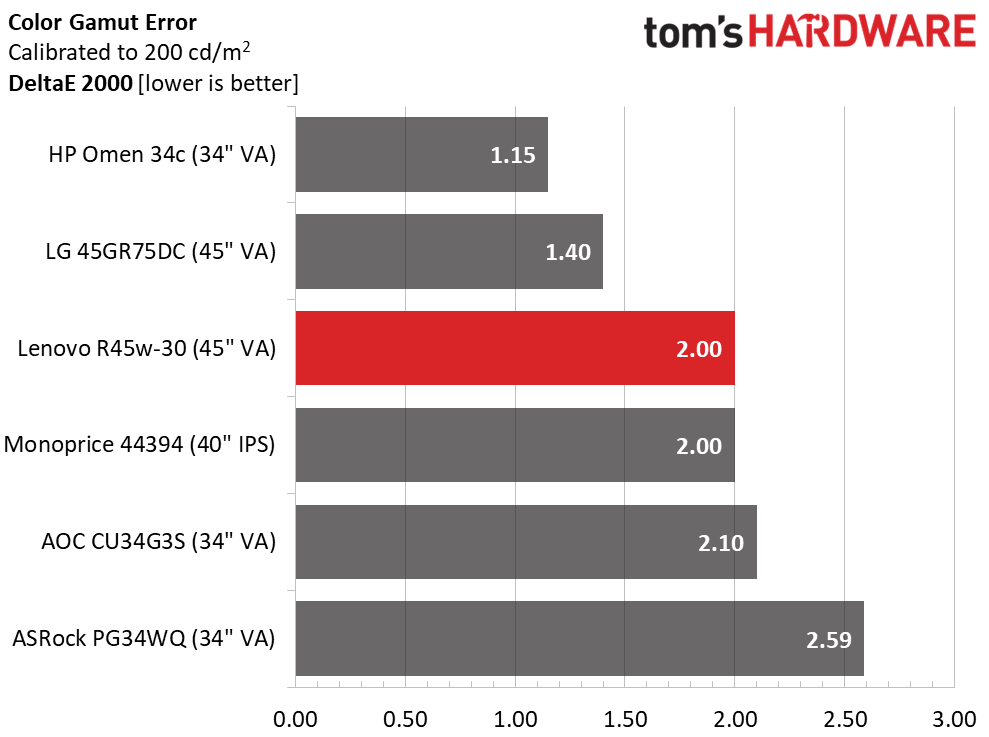
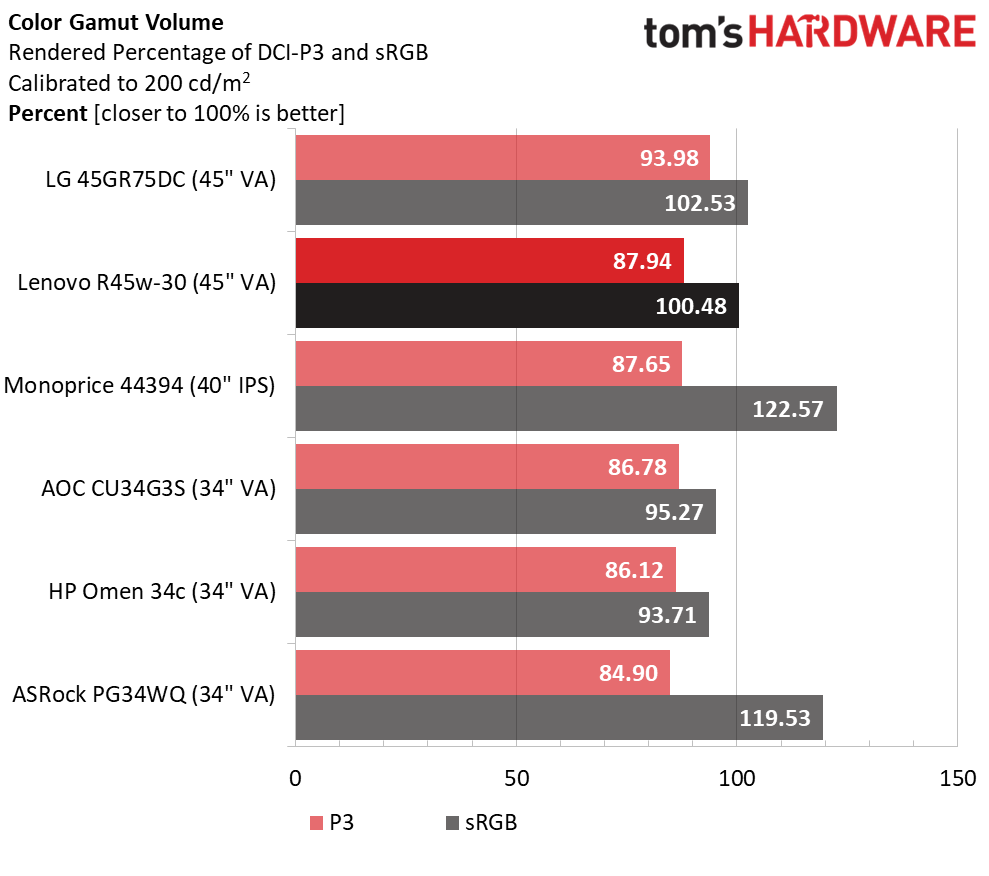
The R45w-30 is right in the mix with its gamut result of 2.00dE. And that’s roughly the same value for both DCI-P3 and sRGB. It performs consistently in both modes, which is a good thing. Whether you use the R45w-30 just for gaming or for work too, its color will satisfy.
Gamut volume is on the high side of average for the genre. You won’t find too many ultra or mega wide monitors with 100% coverage of DCI-P3 at the sub-$1,000 price level. The R45w-30 does a solid job in this regard. It has more than enough color for SDR and just enough to deliver good HDR. The 100.48% coverage of sRGB is ideal, having neither too much nor too little volume.
Test Takeaway: The R45w-30’s grayscale, gamma and gamut metrics have no visible issues. Calibration is required for the best picture, but you can just get away with the default settings because the error tends to red. It has average to high color volume among ultra and mega wide screens to where any more color would cost you significantly more money. At its price level, the R45w-30 has excellent and very competitive color performance.
MORE: Best Gaming Monitors
MORE: How We Test PC Monitors
MORE: How to Buy a PC Monitor
MORE: How to Choose the Best HDR Monitor
Current page: Grayscale, Gamma and Color
Prev Page Brightness and Contrast Next Page HDR Performance
Christian Eberle is a Contributing Editor for Tom's Hardware US. He's a veteran reviewer of A/V equipment, specializing in monitors. Christian began his obsession with tech when he built his first PC in 1991, a 286 running DOS 3.0 at a blazing 12MHz. In 2006, he undertook training from the Imaging Science Foundation in video calibration and testing and thus started a passion for precise imaging that persists to this day. He is also a professional musician with a degree from the New England Conservatory as a classical bassoonist which he used to good effect as a performer with the West Point Army Band from 1987 to 2013. He enjoys watching movies and listening to high-end audio in his custom-built home theater and can be seen riding trails near his home on a race-ready ICE VTX recumbent trike. Christian enjoys the endless summer in Florida where he lives with his wife and Chihuahua and plays with orchestras around the state.
-
Neilbob Looks decent enough, and it'd be nice to have for certain things, but I just don't think I'd be able to work with that aspect ratio. Multiple smaller monitors > a monitor that could double up as a surfboard. I'm old fashioned like that.Reply
But I'd be terribly impressed if someone could legitimately tell the difference between 165 and 170 Hz. I might buy 'em a beer or something. -
pixelpusher220 Reply
Same. Something about the separate monitors that mentally works better for me. Another thing with massive wides is if you do any zoom/screen sharing. I have a colleague at work (remote) who when he shares his ultrawide it tries to share the *whole* thing into my 27" making it basically unreadable.Neilbob said:Multiple smaller monitors > a monitor that could double up as a surfboard. I'm old fashioned like that.
-
cknobman I've always been curious about ultra wides like these but never quite enough to pull the trigger.Reply
As a developer I always have 2-4 screens going and really value as much screen space as possible.
Just not sure that curve would be good staring at all day. -
thors_spatula Reply
"There are many choices in the 21:9 aspect ratio, but by the numbers, they only equal one-and-a-half 16:9 screens."Admin said:The world of extreme gaming monitors grows by one with Lenovo’s Legion R45w-30. It’s a 45-inch DQHD VA curved panel with 5120x2160 pixels, 170 Hz, Adaptive-Sync, HDR400 and wide gamut color. It’s like a window to your favorite games.
Lenovo Legion R45w-30 45-inch mega-wide gaming monitor review: Like a window into virtual worlds : Read more
One-and-a-third. -
FoxTread3 March 23, 2024 - I think it is kind of fun the way many of us humans like big things.. I have my favorite female anatomy measurements ;):cool: I have a Dell 32" LCD monitor and an Alienware 34" OLED monitor. For sharpness and color accuracy, the Alienware wins hands down. When the Dell dies, I'll replace it with another OLED. I use the desktop PC that the Dell is connected to. To do all of the usual online stuff like surfing, reading and writing emails etc. I even watch videos on it. However, for the best video viewing I use my other desktop PC connected to the 34", and that is also my gaming setup. I guess some people really benefit from having a curved monitor, but I find my LG 55" OLED TV fills my needs for a large screen with OLED video quality.Reply -
kira-faye For $800... Just buy a used 42" 4K OLED. You'll never catch me paying that kind of money for an LCD panel.Reply
I got my 42" Sony for $600 by being patient watching local ads. -
pixelpusher220 Reply
a 4K screen isn't ultra wide. Entirely different form factor.kira-faye said:For $800... Just buy a used 42" 4K OLED. You'll never catch me paying that kind of money for an LCD panel.
I got my 42" Sony for $600 by being patient watching local ads.
